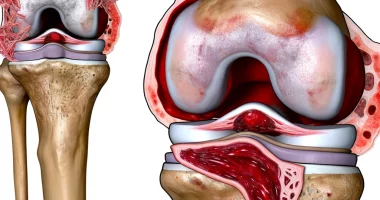Tibial fracture
About the disease
A tibia fracture is a disruption of the integrity of the tibia and fibula bones.
These injuries account for an average of 10% of the total fracture structure. These fractures may be non-displaced or displaced (the second variant belongs to complex traumatism). Ankle fractures (distal segment of the tibia) may be combined with ankle joint damage, and condyle fractures may lead to knee joint damage.
Symptoms of tibia fracture are intense pain, swelling, hemorrhage in soft tissues, impaired leg support function, crepitation, and deformity of the lower limb. The diagnosis of this injury is carried out according to the data from the radiographic examination in several projections. When combining bone trauma with intra-articular damage, a layer-by-layer scan by computed tomography or nuclear magnetic resonance is performed.
Treatment of tibia fractures is possible with conservative or operative methods. In the first case, the anatomy of the bones is reconstructed by manual techniques or skeletal traction with subsequent fixation with a plaster cast. In the second, open surgery is performed, allowing the fragments to be in the correct position and fixed in this state. The operation ends with layer-by-layer tissue repair, suturing, and leg fixation with a plaster cast.
Types of tibia fractures
According to clinical guidelines, the following types of tibia fractures are distinguished by localization:
- Upper segment fractures in which the line of injury is in the area of the head or neck of the fibular bone (apical fracture) or the area of the tibial tuberosity or tibial condyles;
- Mid-segment fractures – the line of injury passes through the body of either the fibula or tibia or involves both bones;
- Fractures of the lower segment – the line of injury passes in the ankle area (such a fracture can be uni- or bilateral).
Open and closed fractures are distinguished depending on the skin’s involvement in the injury. In the first case, the integrity of the skin over the damaged bones is broken, and in the second, it is not.
The line of bone damage can have different directions. Based on this feature, oblique, transverse, and spiral fractures are distinguished. If several bone fragments are formed, we discuss a fragmentary fracture. In the case of many fragments, we are talking about a complex type of traumatism.
Symptoms of a tibia fracture
Clinical signs of tibial fractures may include the following:
- painful sensations that increase when palpating the leg or trying to move;
- swelling in the area of the injury and visually identifiable bruising;
- unnatural positioning of the leg, e.g., if the outer condyle is damaged, the leg is tilted to the outside, and if the inner condyle is damaged, the leg is tilted inward;
- a severe limitation in the mobility of the leg;
- functional impairment – the lower limb is no longer supported because the integrity of the bones is compromised;
- bone cracking (crepitation) when palpating or trying to move the leg.
If the knee or ankle joint is injured simultaneously, in addition to the above symptoms, hemarthrosis is observed, i.e., blood accumulates inside the joint. This condition, if not treated in time, can threaten unfavorable consequences. Thus, in the remote period, such a complication as deforming osteoarthritis can be formed, in which there is a gradual destruction of the cartilage plate, and a persistent pain syndrome appears.
Causes of tibial fracture
Causes of tibial fractures are associated with domestic, sports, or occupational injuries. The nature of the bone injury is determined by the point of application of an external force and its direction.
- The tibial condyles are usually broken in a fall from a height. They can be split or compressed (compression fractures).
- Direct and indirect trauma usually results in fractures of the tibial or fibula body. If the connective tissue membrane connecting them is intact, there is no displacement of the fractures.
- If the foot is turned sharply to the outside or inside, the ankles may be broken. The ankles may also be injured by direct impact.
Stress fractures are a separate category. They occur when the tibia is subjected to prolonged mechanical loads, the strength of which is almost comparable to the bone strength reserve. Such fractures may occur in athletes and long-term marching military personnel.
Diagnosis of a tibial fracture
Diagnosis of a tibial fracture involves objective examination and palpation. An X-ray scan is performed in at least two projections to establish a definitive diagnosis. The radiographs visualize the line of injury and the position of bone fragments. If joints are involved in the traumatic process, computed tomography or magnetic resonance imaging is performed to detail their condition.
Treatment of a tibial fracture
Treatment of the fracture is determined by the nature of the injury and the involvement of joints nearby. Both conservative and surgical tactics are acceptable.
Conservative treatment
Conservative treatment is recommended when there is no displacement of bone fragments. In this case, a leg cast is applied for 3-4 weeks. The immobility of bone fragments creates conditions for the proper fusion of the fragments (osteoblasts synthesize bone tissue).
If there is displacement of the bone fragments, manual repositioning is performed. If the attempt is successful, a leg cast is applied.
Surgical treatment
Skeletal traction or open surgery is indicated if manual repositioning is ineffective. In the latter case, plates and screws are used to fix the bone fragments in the correct position. Surgery for tibia fractures makes it possible to restore bone anatomy even with complex injuries.
All these treatment options are available in more than 850 hospitals worldwide (https://doctor.global/results/diseases/tibial-fracture). For example, Intramedullary nailing can be performed in 29 clinics across Turkey for an approximate price $2.8 K (https://doctor.global/results/asia/turkey/all-cities/all-specializations/procedures/intramedullary-nailing).
Prevention
Tibia fracture prevention is aimed at preventing injuries. To this end, taking precautions during cold season, wearing seat belts when driving, and using safety ropes when working at heights are recommended.
Rehabilitation after a tibia fracture
After removing the leg cast, the rehabilitation period after a tibia fracture begins. At this stage, it is recommended to perform physical therapy exercises and physical procedures according to an individually designed program. In uncomplicated cases, a whole load on the leg is allowed in 2-3 months from the date of injury. By this time, the fracture zone becomes fully consolidated (fused).





